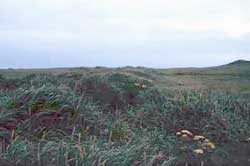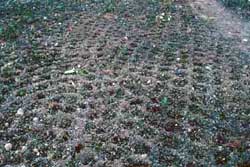Chapter 12: Natural Revegetation With time, most disturbed sites will revegetate naturally. However, very few landowners and managers find this revegetation approach acceptable. Proper surface preparation and fertilization can hasten the establishment of native plants, but the process can take many years. Also, prediction of the eventual cover or species composition of an area designated to be revegetated by natural processes is uncertain. Even an educated guess may have serious flaws if certain predetermined conditions need to be met on the disturbed site. 
Figure 8: An area selected for natural revegetation monitoring on Shemya Island. This road is being reclaimed with a locally excavated peat overlay that is allowed to develop a vegetation cover without assistance.
Most people considering natural revegetation fail to recognize the fact that it is actually an active process. Simply doing nothing is not “natural revegetation” as defined by professionals in the field. At the very least, an active monitoring program needs to be in place to prevent erosion and/or invasive species encroachment. In short, this technique does not mean “walk away from the site”. Natural revegetation can be assisted or enhanced with any combination of surface preparation or modification techniques, fertilizers, soil amendments and even light seed applications. This then becomes “enhanced natural revegetation”, an acceptable alternative to natural revegetation. Anyone wishing to apply this technique must understand the potential for failure and be willing to move to an active form of revegetation if the process does not perform well or erosion and other problems emerge. 
Figure 13: The effect of natural revegetation after
two years. Note the establishment of woody species.

Figure 15: An area being prepared for natural revegetation by using a ripper bar on a grader.
This is the final condition of the prepared surface.
The author prefers enhanced natural revegetation over all other forms, but has rarely applied the technique, as few sites actually offer either the ideal conditions or the regulatory process precludes methods that cannot give specifics of final vegetative cover and/or composition. Wright, Stoney J. 1991. Assessment of Revegetation on the Aleutian Islands – Adak, Amchitka, Shemya, and Attu. State of Alaska, Division of Agriculture, Plant Materials Center. 12 pp. Wright, Stoney J. 1993. Gravel Pit Restoration Using Imprinting to Encourage Natural Revegetation by Woody Species on Fort Richardson, Alaska. Abstracts of the 1993 American Society of Agronomy Annual Meeting, November 7-12, 1993, Cincinnati, Ohio. 1 pp. Wright, Stoney J. 1995. Atigun Pass Reroute Rehabilitation Project - Final Report. State of Alaska, Division of Agriculture, Plant Materials Center. 65 pp. Wright, Stoney J. 1997. Final Report – Natural Revegetation of Peat Soils on Eareckson Air Station, Shemya Island, Alaska – A Qualitative Study of a Natural Process. State of Alaska, Division of Agriculture, Plant Materials Center. 21 pp. Wright, Stoney J. 2000. Final Report – Mile Post 22 Revegetation Study. State of Alaska, Division of Agriculture, Plant Materials Center. 24 pp. |





